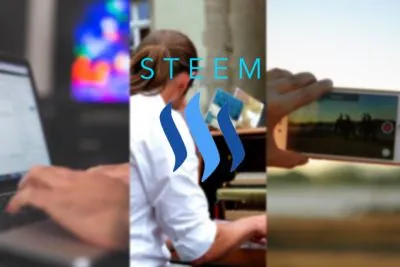I had first heard of cryptocurrencies back in 2013. I discovered Bitcoin one day, and went as far as creating a wallet.
Only in 2017 did things really begin to pick up— the thought of a world economy with money, finances, bonds, and shares moving through the air at lightning-speed— walking up to your coffee shop, scanning a QR code, and transmitting money with negligible fees— sending tips online at the click of a button.
While it is thought of as an underdog or "altcoin" now, I personally believe STEEM is a true contender for the title of "supercurrency" and a potential competitor to Bitcoin itself, and that it truly has has the power to rise above other cryptocurrencies in many regards.

Steem as a Cryptocurrency

One of the most underestimated facets of STEEM is its core blockchain.
As with Bitcoin and hundreds of other cryptocurrencies, the entire platform relies on a decentralized ledger, or blockchain, publicly and transparently recording every transaction.
However, the Steem Blockchain was intelligently built to outpace other cryptocurrencies in a number of ways.
Feeless Freedom
Blockchains generally require fees to publish transactions, in order to limit spam and prevent useless microtransactions from sucking up storage space for users. However, if you've ever made a transaction on Steem, you know that there's absolutely no fee needed to do so. How's that possible?
Steem replaces the fee mechanism with the notion of bandwidth. Every user has a set amount of bandwidth, representing the amount of storage space they can use up on the blockchain in a set amount of time.

This number varies from person-to-person and depends primarily on the amount of Steem Power you hold.
Currently, the fee required per transaction on Bitcoin is over $3 (source), making normal transactions economically impractical and microtransactions impossible.
It's not practical for me to buy my morning mocha in Bitcoin if I have to pay double for it. Credit Card companies charge fees from both merchants who accept credit cards and the people who use them, while Steem takes fees from nobody.
Instant Confirmation

The Bitcoin Network and most of its popular forks rely on a ten-minute block gap to propagate transactions.
Due to the infrequency of blocks, it can take quite some time for a transaction to confirm. It's only safe to accept a confirmed Bitcoin transaction, so merchants and receivers generally wait for confirmations before even registering your payment, which means lots and lots of waiting.
On Steem, the block between gaps is 3 seconds. Every three seconds, a new block with new transactions is propagated to the blockchain. No more waiting for confirmations— on Steem, the moment you press Transfer your money is sent instantly.
The lack of fees and instant confirmation time means that Steem is truly equipped to be perfect for microtransactions. At the current stage with other cryptocurrencies, walking into a coffee shop and waiting for confirmations or paying excessive fees seems more cumbersome than swiping a credit card, which is the opposite of what we want.
But with Steem, I can simply tap a button and send my money with no fees, no middlemen, no banks, and absolutely no waiting.
Delegated Proof of Stake
Cryptocurrency blocks need to be bound by certain consensus algorithms that decide who can publish a block, and how blocks are validated.

Bitcoin relies on proof-of-work for consensus, which requires immense amounts of computing power and energy to operate.
This leads to lots of wasted energy, and can easily lead to unhealthy centralization of mining.
Steem relies on an all-new battle-tested algorithm coined by @dan called Delegated Proof-of-Stake, or DPOS, known to be the most efficient, most fair, most democratic, and most flexible model available.
DPOS relies on witnesses, or delegates, who represent the users of the blockchain and are elected by them. These witnesses can jointly alter all network parameters from transaction size to block interval.

Every single Steem user or stakeholder can participate in the election process by voting for witnesses, and their vote is judged proportionally to their stake.
This unique model allows for every single user to have a voice and a way to choose the best witnesses to operate on the network.
Rewarding your Voice
Steem, like other cryptocurrencies, has its own purpose and niche. If achieved, Steem could alter the publishing, journalism, and blogging industry forever.

Steem allows its users to publish articles, posts, blogs, and stories to the blockchain, where they can be read by other users. If a user likes an article, they can upvote it.
Every day, the blockchain fills up a reward pool with STEEM to be paid out to users. The simple action of tapping the upvote button dedicates a fraction of this pool to the post.
After seven days, this fraction of the reward pool pays out and the author receives cryptocurrency for their post or article.
Steem provides the most seamless and direct way to reward content creators. On other blogs or similar websites, distracting advertisements are necessary to generate revenue from users. On news websites and publications, subscription models and paywalls are necessary to make profit.
But on Steem, nothing is blocked by a paywall; users simply upvote worthy content, and if your content is appreciated by other users, you can easily earn real cash.
The Future of Steem: SMT Oracles
Steemit CEO @ned recently introduced the concept of SMT Oracles in his post here. He envisioned a world, "incentivizing real world actions, such as exercising, writing and coding," based on event confirmations with the Steem Blockchain.

Smart Media Tokens allow for new platforms and services to extend off Steem and build their own Steem-like tokens powering their own content-fueled networks.
Oracles are gateways between the blockchain and the real world.
Supported and compensated by other users, oracles can jointly confirm that certain events occurred in real-life, and publish this data to the blockchain to possibly reward those involved in the action.
Extending Compensation
Steem was originally made for compensating and rewarding articles and writing, but it is constantly being expanded into new categories. DTube allows for your video content to be rewarded, while DSound rewards audio.
Utopian rewards open-source contributions, from code development to bug hunting to translations, and more. Appics is a smart media token coming out soon, rewarding your pictures. The release of Smart Media Tokens and Oracles will only grow the list of actions and activities Steem can reward.
With all this in mind, it's clear how Steem brings the perfect qualities necessary to sustain itself as a cryptocurrency. I wouldn't be surprised to see Steem competing with bigger names like Bitcoin and Ethereum quite soon!
Thanks for reading,
— @mooncryption